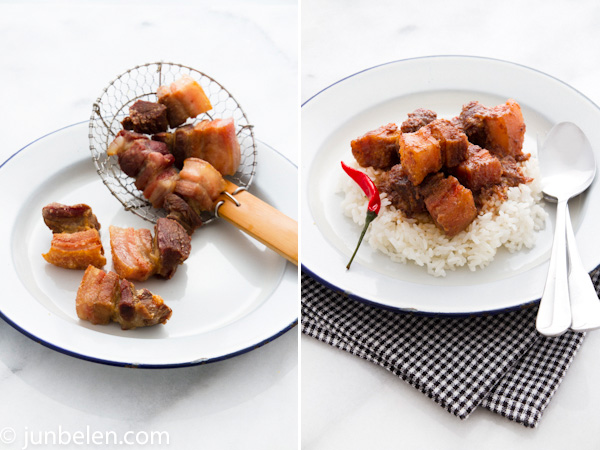Deep frying pork belly is not for the timid, in my opinion. It calls for boldness. The pork pops and crackles violently in the seething pool of oil. Even if one compulsively pats the pork belly dry, the very hot oil still spatters in all directions. The menacing hot grease lands everywhere. On one’s fingers, on one’s arm, and on one’s once-spotless shirt.
The bold, distinct scent and taste of bagoong is not for the timid, too. Bagoong [bah-goh-ohng], for the uninitiated, is tiny shrimp, fish or other shellfish mashed with salt and then allowed to ferment until it becomes an intensely pungent but flavorful paste. The late food writer Doreen Fernandez wrote about bagoong from the island of Negros Occidental where shrimp that are too small to sell in the markets are mashed in the boats on the shore, with the boatmen mashing them with their bare feet and their paddles.
Bagoong alamang is the paste made from shrimp while bagoong isda is salted and fermented fish like anchovy and round scad. Bagoong Balayan is a version of bagoong isda that originated from Balayan, a town in the province of Batangas, south of Manila. It isn’t a thick paste like most bagoong but it is a smooth liquid without the faintest trace of the once-spiny fish bones that have all melted through fermentation. Whole fish grilled over hot coals accompanied with steamed sweet potato sprouts — talbos ng kamote — is impeccable with bagoong Balayan and a squeeze of calamansi juice.
Sour green mangoes are inconceivable without bagoong alamang and so is kare-kare, the stew of oxtail and vegetables flavored with toasted peanuts and thickened with pounded rice. When I eat alone at home and I pine for something simple, steamed rice fluffed with a fork and mixed with bagoong alamang sauteed in garlic, onions, and tomatoes is my go-to meal. But when I crave extravagance, crispy pork belly dressed lavishly in briny bagoong alamang — binagoongan — is the unequivocal choice. The burns on my fingers and arms, not to mention my soiled shirt, are all well worth it.
Binagoongan Recipe, makes 4 servings
1-1/2 lb pork belly, cut lengthwise into 2-inch thick slabs
6 cloves garlic, crushed
1 tablespoon salt
vegetable oil for deep frying and sauteeing
1 small onion, chopped
1 tomato, chopped
1/2 cup bagoong alamang (salted, fermented shrimp paste)
a few Thai chilies (optional)
Place pork belly, 2 cloves of garlic, and salt in a pot and add water, enough to just cover the pork. Bring to a boil and reduce to simmer. Continue to cook until the pork is fork-tender, about an hour.
Drain the pork. Measure 1/2 cup of pork stock and reserve the rest for future use. Pat the pork dry with paper towels and cut into 2-inch pieces.
Fill a wok or a pot with at least 2 inches deep of oil and heat the oil. Deep fry pork in small batches until brown. Fish out with a strainer and place on a platter lined with paper towels.
Heat oil in a pan over medium high heat. Saute onions until fragrant and softened, about 5 minutes. Add the rest of the garlic and saute until lightly browned, about 2 minutes. Add tomatoes and saute until softened, about 5 minutes. Add bagoong alamang, 1/2 cup pork stock, and chilies. Bring to a boil and simmer for 5 minutes. Add pork belly and combine well. Serve warm with steamed rice.

